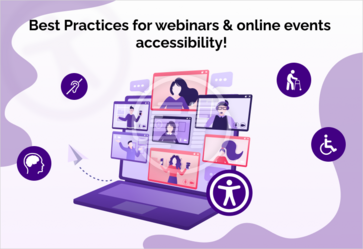Americans with disabilities act (ADA) has become the talk of the town lately and do you know, why organizations have started making ADA a priority? Because the government has made it mandatory for every digital solution adhere to ADA guidelines in order to make the digital world accessible for everyone irrespective of their physical and cognitive abilities.
Have you ever checked the statistics of different surveys that say a profound number of digital users suffer from some or other sort of disability? Thus, it is even your moral responsibility to provide an accessible ecommerce website or online store to such users.
ADA is more crucial for ecommerce stores because now everyone is dependent on online stores for all smaller and bigger needs. But at times, it becomes problematic for people with disabilities to explore ecommerce sites and shop for their desired products due to site’s inaccessibility.
The inaccessible ecommerce stores also lose customers and their competitors with accessible websites get benefits by acquiring those users. Therefore, ecommerce stores must follow ADA standards.
YOU MAY ALSO LIKE: ADA Tax Credit
Important of Ecommerce ADA Compliance
As we know, the main idea behind ADA is to eliminate discrimination against people with disabilities. ADA is based on the Civil Rights Act of 1964, which advocates the rights of disabled people. The ADA is a prominent reason why the internet is transforming into an accessible place for everyone.
Do you know, what Title III of the ADA says?
It prohibits every public entity including ecommerce stores/websites, from discriminating and being biased against people with disabilities. It is the owners’ responsibility to accommodate every user coming to their ecommerce website by providing them with accessible solutions.
After many lawsuits have been filed, courts have found that online retailers and ecommerce websites must comply with the guidelines indicated in the ADA. If your ecommerce website is not complying with ADA, you will be held liable, and a lawsuit may be filed as well against your organization for troubling people with disabilities.
To avoid such lawsuit, you can check our article on how to avoid ADA lawsuit!
Other than legal grounds, when you build an ADA-compliant ecommerce website, you give the amount of attention and care to people with disabilities, that they deserve.
ADA's Main Principles for Ecommerce Website
When it comes to web accessibility, you must adhere to WCAG standards. It indicates the goals for enacting ecommerce ADA compliance. ADA is a part of WCAG, which has four core principles to create an accessible ecommerce.
- Easy to perceive – Users who visit your ecommerce website, should be able to perceive texts, images, videos, and all the information available easily. There must be alternatives for videos, audio, and images for users who cannot see or hear.
- Easy to operate – If users are searching for some products, they should be able to navigate your ecommerce store and access all the products they are looking for. Breadcrumbs make the website’s navigation easier.
- Easy to understand – The content of the website including text, images, and videos must be comprehensive for everyone. To make it clearer, adding instructions, text-to-speech, etc. are good options.
- Robust – Every single user who visits your ecommerce store should receive a similar experience. For instance, if you’ve added text-to-speech content, it must convey the same message, which other users receive who don’t use assistive technologies.
Things to check for ecommerce ADA accessibility solution
An ecommerce website’s important features must be ADA accessible. To ensure their accessibility, you should test them against WCAG standards.
1. Check-out process
This is one of the most crucial parts of any ecommerce website. If checkout is difficult to navigate or understand, users are most likely to leave their carts abandoned. The checkout process is necessary to be optimized in order to save conversions. Because people with disabilities will get frustrated if they will be unable to move, fill inputs, or use features, and eventually they will not complete their transactions.
To optimize the checkout process, make it one-page, easy and simple, avoid asking for unwanted information, provide instructions to fill the form fields, and ensure smooth navigation.
YOU MAY ALSO LIKE: Customer Engagement Strategies Ecommerce
2. Payment Gateways
Every ecommerce website needs to have more than one payment gateways to offer multiple payment choices to customers. The integration of these payment gateways should get done in a way that every single user will be able to pay via their choice of methods without any problem.
All payment gateways must be adhering to Payment Card Industry Standards (PCI) in order to offer secure transactions. Also, every payment method must be optimized for multiple currency, multiple languages, screen readers, and other assistive technologies. There should be popup blockers so that users don’t get distracted during payment. A successful payment message must show to the users after payment completion.
3. Search Bar
Ecommerce website is expected to have quick search option. There should be visible search bar, which can be easily accessed. Search bar should automatically suggest products when typing or saying keywords. It should be placed at top of each page and must be easily navigable.
4. Call-to-Action
If call-to-action buttons are non-accessible using keyboards, then a few users might not be able to explore your ecommerce website and complete their actions.
5. User focused personalised experience
Ecommerce stores offer personalised experience to their customers. Focus on providing similar experience to every customer. Send push notifications and other personalised elements that can be comprehensive for users who use assistive technologies to peruse your ecommerce website.
6. Wishlist and Shopping cart
Product selection and adding them to Wishlist or shopping cart must be easier for users with disabilities as well. Likewise, other options, Wishlist and Shopping cart are expected to be easily navigable using keyboard or assistive technologies.
7. Mobile Ecommerce Accessibility
This is one of the important factors from ADA point of view as well since a profound number of mobile users are disable who use their mobile phones for shopping. Thus, make sure your ecommerce web app is optimized for all mobile phones according to ADA guidelines.
8. User generated reviews
Ecommerce owners put reviews and comments to gain trust of other users to improve conversion. These reviews must be accessible and understandable to users with any sort of disabilities as well.
9. Menus
The structure of website is reflected by the navigation menus. The keyboard and screen reader users are getting advantage from keyboard operability and markup to operate menus in multiple ways. While the users with motor difficulties who are using touch screen devices need larger targets to tap on or to click. Make sure that in fly-out menus and submenus must not disappear instantly after the mouse has left the clickable area. People with limited attention can benefit from distinct and clear menus with identifiable states like current page.
10. Multi-lingual ecommerce store
If your store is available in multi-language, then it must be optimized and coded in way that assistive technologies like screen readers and braille devices can use it. Once it is recognized, it can automatically switch to language, pitch the content, and adjust the accent. Jaws and Window Eyes can speak multiple languages with proper pronunciation.
11. Audio descriptions
Ecommerce stores often put videos to make their content more impressive. These videos need to be accessible so that they will reach to the right audience. Thus, to make the videos ADA-accessible for everyone, ecommerce stores can offer audio description with videos. It is basically detailed description of visual elements with pauses and other sounds.
12. Operations
Ecommerce operation includes shipping, logistics, SKU or warehouse management, etc. Once users place their orders, they must get a readable or understandable confirmation message or mail or both. Moreover, SKU management should be in a way that if a product is out of stock, it should be clearly mentioned to avoid any confusion. And ensure that every user will be able to track order directly or using any assistive technology.
13. Multi-vendor marketplace
Each vendor’s store must adhere to ADA-compliance in order to offer seamless experience to the users with disabilities.
YOU MAY ALSO LIKE: Multi-Vendor Marketplace Platforms
14. Compatibility
For a successful ecommerce website, it needs to be compatible with every browser and devices. Thereby, all the users can access and explore the ecommerce store from their desired browsers.
Other than these features, every ecommerce website must have basic ADA adherence.
15. Color Schemes
Make sure the ecommerce website has proper color contrast as per ADA / WCAG standards (4.5:1) keeping users with low vision or color blind in mind. They might face issues to identify objects if the color contrast is inappropriate. So, use colors that don’t cause problems.
16. Form fields
Ecommerce forms need proper coding or else they will be a big hassle for users with disabilities. Accurate labels, error messages, and correct instructions are required for an accessible form.
17. Alt text
Ecommerce is incomplete without product images and the images without alternative text will not be comprehensive for everyone. Thus, alt text is essential with every image to describe them aptly. Users who rely on screen readers, need alt text to understand images.
ADA compliance enhances ecommerce websites' reach!
Though you are making ADA compliant ecommerce store for users with disabilities but improving UX and UI helps your website to grow the business as well. ADA accessible ecommerce websites will be used by more people no matter what their physical state is.
It not only increases your conversions and profits but also decreases the chances of litigation. A compliant ecommerce website has lesser abandoned cart issues, more returning customers, happier old (retained) customers, and elevated revenue. In a nutshell, it is a win-win deal for customers and your organization both.
“You cannot just start an ecommerce website and expect people to flood in. If you really want to succeed, you have to create traffic.” - Joel Anderson
As an associate member of International Association of Accessibility Professionals (IAAP), Skynet Technologies is a part of Global accessibility community. Our commitment to the IAAP guarantee people all over the world to understand and implement accessibility strategies.
We are also an official member of the W3C.
Skynet Technologies provide comprehensive ADA website accessibility services which includes ADA website audit, strategy, design, development, remediation, and support with accessibility regulations such as ADA, WCAG 2.0, 2.1, and Section 508 within your budget. Contact us at hello@skynettechnologies.com or fill out form below to request a free quote.


